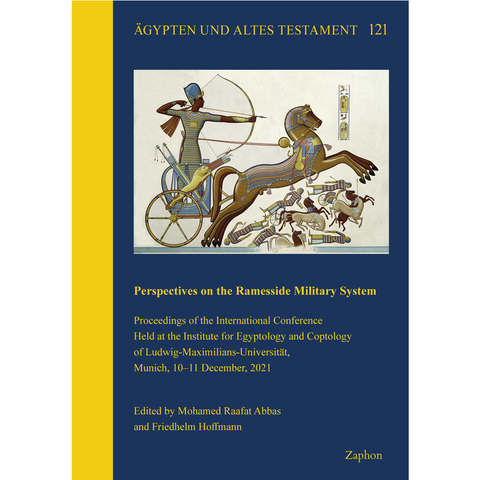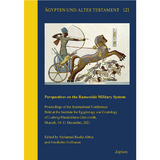Perspectives on the Ramesside Military System
Proceedings of the International Conference Held at the Institute for Egyptology and Coptology of Ludwig-Maximilians-Universität, Munich, 10–11 December, 2021
Seiten
Der Band versammelt die Beiträge einer Konferenz über das ramessidische Militärsystem, um neue archäologische und historische Perspektiven auf die gesamte militärische Perspektive Ägyptens zu dieser Zeit zu eröffnen. Ziel der Konferenz war es, eine umfassende Bewertung des aktuellen Wissensstands über das ramessidische Militärsystem vorzunehmen und zu diskutieren, wie das neue Wissen mit früheren Theorien zusammenhängt. Die militärischen Aktivitäten Ägyptens waren während der Ramessidenzeit (Dynastien XIX–XX, 1310–1100 v. Chr.) von großer Bedeutung und ein wichtiger Teil der historischen Entwicklungen während des Neuen Reiches sowie in der zeitgleichen Spätbronzezeit des Alten Orients. – Auf der Grundlage archäologischer, ikonografischer und textlicher Beweise sammelte Mohamed Raafat Abbas die Zeugnisse des Libyenkrieges von Ramses II. – Mohamed Abd el-Maksoud und Elsayed Abd el-Alim erörterten die Befestigungsanlagen von Tell Heboua (altes Tjaru) im Norden des Sinai, die die Ostgrenze Ägyptens am Pelusischen Nilarm am Ausgangspunkt der sogenannten Wege des Horus sicherten. – Peter J. Brand untersuchte wiederkehrende ideologische Themen in den monumentalen Militärtexten und Reliefs von Sethos I. und Ramses II. – Die Festung Tjaru wurde von Ola El-Aguizy vorgestellt. – James K. Hoffmeier diskutierte die Festung Tell el-Borg, einen der Stützpunkte entlang der Wege des Horus im Nordsinai, und konzentrierte sich dabei auf die Rekonstruktion der antiken Landschaft. – Jozef Hudec befasste sich mit der Festung Tell el-Retaba östlich von Ismailia. Jüngste Ausgrabungen der Polnisch-Slowakischen Archäologischen Mission brachten zahlreiche Strukturen innerhalb der Festungen zu Tage und lieferten neue Informationen über die Verteidigungsmauern. – Der in den Kriegsschauplätzen der Ramessiden so herausragende Streitwagen wurde von Heidi Köpp-Junk in seiner historischen Entwicklung von den frühesten Zeugnissen bis zum ersten Jahrhundert v. Chr. behandelt. – Alberto M. Pollastrini befasste sich mit Schuppenpanzern, die als Kriegsbeute oder diplomatische Geschenke erwähnt und gelegentlich abgebildet werden. – Sylvia Schoske befasste sich mit der Stele ÄS 8025 aus dem Ägyptischen Museum München. – Steven Snape konzentrierte sich auf die Festung Zawiyet Umm el-Rakham westlich von Marsa Matruh, die von Ramses II. gegen die Libyer zur Sicherung des Küstenhandels errichtet wurde. – Schließlich zeigte Anthony Spalinger, dass das Studium von Standpunkten eine aufschlussreiche Strategie bei der Analyse literarischer Kompositionen der Antike war. The volume assembles the contributions of a conference on the Ramesside military system that aimed to shed light on new archaeological and historical perspectives concerning the entire military outlook of Egypt at this time. The intention of the conference was to make a broad assessment of the current state of knowledge about the Ramesside military system and discuss how the new knowledge relates to previously held theories, and to provide a forum for discussion. The Egyptian military activity was very significant during the Ramesside Period of Egypt (Dynasties XIX–XX, 1310–1100 BC) and was an important part of the historical developments during the New Kingdom of Egypt as well as in the contemporary Late Bronze Age of the ancient Near East. – On the basis of archaeological, iconographical and textual evidence, Mohamed Raafat Abbas collected the attestations of the Libyan war of Ramesses II. – Mohamed Abd el-Maksoud and Elsayed Abd el-Alim discussed the fortifications at Tell Heboua (ancient Tjaru) in north Sinai which secured Egypt’s eastern border at the Pelusiac branch of the Nile at the starting point of the so-called Ways of Horus to Palestine by protecting the crossing of the Nile at a strategically suitable place. – Peter J. Brand examined recurring ideological themes in the monumental military texts and reliefs of Sety I and Ramesses II and their impact on our endeavor to understand the historical context of the wars these pharaohs waged. – The fortress of Tjaru was dealt with by Ola El-Aguizy once more. It is depicted not only in the temple of Karnak, but also in the Ramesside tomb of the Generalissimo Urkhya at Saqqara. – James K. Hoffmeier discussed the fortress of Tell el-Borg, one of the bases along the Ways of Horus in north Sinai, concentrating on the reconstruction of the antique landscape in order to understand the position and the building phases of the fortress. – Jozef Hudec dealt with the fortress(es) of Tell el-Retaba east of Ismailia. Recent excavations of the Polish-Slovak Archaeological Mission revealed numerous structures inside the fortresses, and delivered new information about the defense walls and other defensive installations. – The chariot which is so prominent in the Ramesside war scenes was treated by Heidi Köpp-Junk in its historical development from the earliest evidence until the first century BC. – Alberto M. Pollastrini dealt with scale armours, which are mentioned as booty of war or diplomatic presents and occasionally depicted. – Sylvia Schoske dealt with the Stela ÄS 8025 from the Munich Egyptian Museum. – Steven Snape concentrated on the fortress of Zawiyet Umm el-Rakham west of Marsa Matruh which was erected by Ramesses II against the Libyans for securing the coastal trade. – Finally, Anthony Spalinger showed that studies of points of view have been a revealing strategy in analysing literary compositions of the ancient world. How the author or compiler of a relatively lengthy historical account established his focus upon the narrative automatically entails a certain strategy of presentation.
| Erscheinungsdatum | 22.02.2024 |
|---|---|
| Reihe/Serie | Ägypten und Altes Testament ; 121 |
| Verlagsort | Münster |
| Sprache | englisch |
| Maße | 210 x 300 mm |
| Gewicht | 1000 g |
| Themenwelt | Geschichte ► Allgemeine Geschichte ► Altertum / Antike |
| Schlagworte | Ägypten • Militär • Militärgeschichte • Ramses |
| ISBN-10 | 3-96327-244-9 / 3963272449 |
| ISBN-13 | 978-3-96327-244-8 / 9783963272448 |
| Zustand | Neuware |
| Haben Sie eine Frage zum Produkt? |
Mehr entdecken
aus dem Bereich
aus dem Bereich
Buch | Hardcover (2012)
Westermann Schulbuchverlag
CHF 44,90
Schulbuch Klassen 7/8 (G9)
Buch | Hardcover (2015)
Klett (Verlag)
CHF 29,90
Buch | Softcover (2004)
Cornelsen Verlag
CHF 23,90




